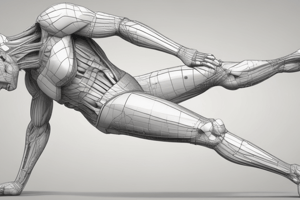Podcast
Questions and Answers
What is the language of the text at the beginning of the page?
What is the language of the text at the beginning of the page?
- French
- English
- Spanish
- Arabic (correct)
What is the title of the content on the page?
What is the title of the content on the page?
- Knee Biomechanics (correct)
- Knee Surgery
- Knee Physiology
- Knee Anatomy
Who is the author of the content on the page?
Who is the author of the content on the page?
- Dr. Lee
- Dr. Smith
- Dr. Johnson
- Dr. (correct)
What is the significance of the numbers ()76 in the text?
What is the significance of the numbers ()76 in the text?
What is the tone of the Arabic text at the beginning of the page?
What is the tone of the Arabic text at the beginning of the page?
What type of force is most likely to cause meniscus injury?
What type of force is most likely to cause meniscus injury?
What is the common mechanism of meniscal injury?
What is the common mechanism of meniscal injury?
What is the location of the meniscal injury?
What is the location of the meniscal injury?
What is the name of the cartilage structure that gets injured?
What is the name of the cartilage structure that gets injured?
What is the position of the knee when the twisting injury occurs?
What is the position of the knee when the twisting injury occurs?
What does the ligament resist during knee movement?
What does the ligament resist during knee movement?
What happens to the LCL during knee flexion?
What happens to the LCL during knee flexion?
What is the function of the ligament in the absence of ACL?
What is the function of the ligament in the absence of ACL?
What type of stress does the ligament resist?
What type of stress does the ligament resist?
What is the primary function of the ligament?
What is the primary function of the ligament?
What is the result of falling on a flexed knee?
What is the result of falling on a flexed knee?
What is the function of the Medial collateral ligament (MCL)?
What is the function of the Medial collateral ligament (MCL)?
What happens to the MCL during knee flexion?
What happens to the MCL during knee flexion?
What is the possible cause of a violent extension meniscal injury?
What is the possible cause of a violent extension meniscal injury?
What are the two collateral ligaments of the knee joint?
What are the two collateral ligaments of the knee joint?
What is likely to cause a valgus stress?
What is likely to cause a valgus stress?
What is the state of the ACL during knee flexion?
What is the state of the ACL during knee flexion?
Which of the following ligaments is NOT mentioned in the text?
Which of the following ligaments is NOT mentioned in the text?
What is the location of the MCL and LCL?
What is the location of the MCL and LCL?
What is the consequence of a direct hit to the lateral side of the knee?
What is the consequence of a direct hit to the lateral side of the knee?
Flashcards are hidden until you start studying
Study Notes
Content Overview
- The language at the beginning of the page is Arabic.
- The title of the content is not specified but related to meniscal injuries and knee anatomy.
- The author of the content is not provided.
Meniscus Injury Details
- The number 76 may signify a specific point of reference or a classification relating to meniscal injuries, likely relevant in medical texts or studies.
- Twisting injuries are commonly attributed to axial forces acting on the knee, particularly during sports.
- The meniscal injury primarily occurs in the knee region, specifically in the medial or lateral meniscus.
- The injured cartilage structure is identified as the meniscus.
Knee Position and Movement
- Twisting injuries typically happen when the knee is in a flexed position, often during rotation of the body while the foot remains planted.
- The ligament resists excessive movement during knee function, providing stability during dynamic activities.
- During knee flexion, the Lateral Collateral Ligament (LCL) experiences tension but is not torn.
- In the absence of the Anterior Cruciate Ligament (ACL), the LCL provides support against lateral movement.
Ligament Functions and Reactions
- The ligament primarily resists varus stresses, which are inward forces causing the knee to buckle.
- Falling on a flexed knee can lead to damage in the patellar region and potential meniscal tears.
- The Medial Collateral Ligament (MCL) functions to stabilize the knee against valgus stresses.
- During knee flexion, the MCL remains taut, protecting the joint from excessive lateral forces.
Causes and Mechanics of Injury
- A violent extension meniscal injury may occur due to abrupt stopping, changes in direction, or hyperextension of the knee.
- The two collateral ligaments of the knee joint are the Medial Collateral Ligament (MCL) and the Lateral Collateral Ligament (LCL).
- Valgus stress is likely caused by external forces applied on the lateral side of the knee.
- During knee flexion, the ACL is typically more relaxed compared to its taut position during extension.
Ligament Locations and Consequences
- The MCL is located on the inner side of the knee, while the LCL is found on the outer side.
- A direct hit to the lateral side of the knee can result in injury to the MCL and potentially lead to instability in the joint.
Studying That Suits You
Use AI to generate personalized quizzes and flashcards to suit your learning preferences.




